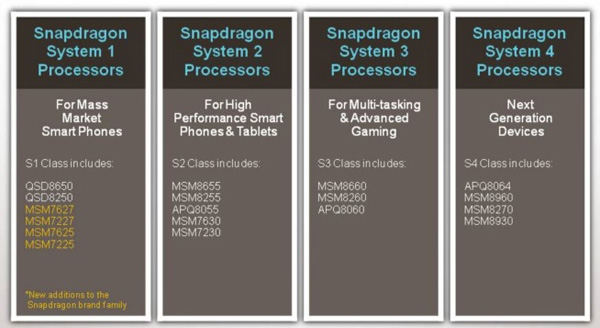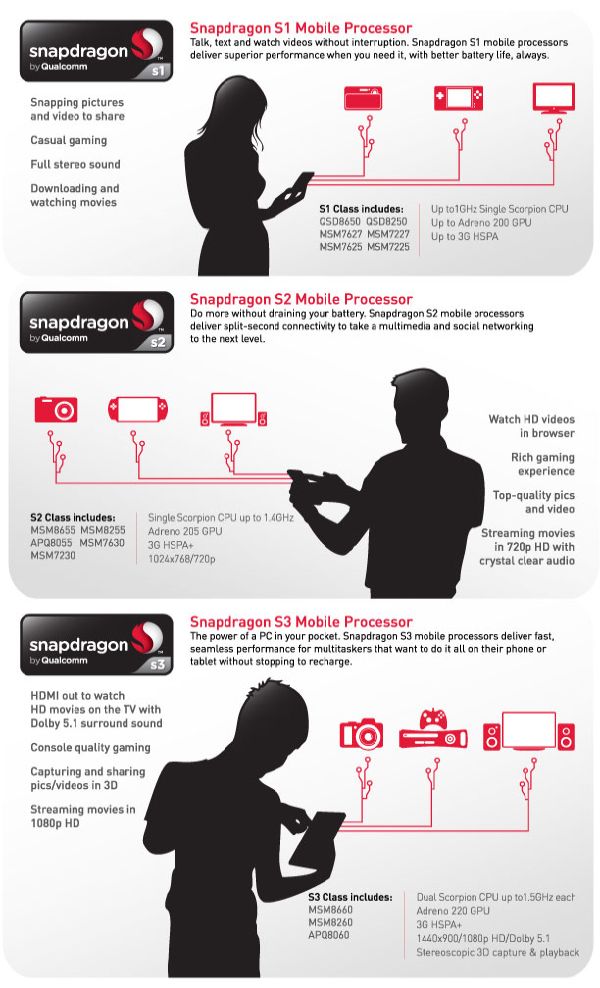Qualcomm's Updated Brand: Introducing Snapdragon S1, S2, S3 & S4 Processors
by Anand Lal Shimpi on August 3, 2011 10:00 AM EST- Posted in
- Smartphones
- Snapdragon
- Qualcomm
- Mobile
- Tablets
- SoCs
All microprocessor companies struggle with the same basic marketing problem: how do you explain to the average consumer why one part is faster than another without saying cache, GHz or cores. Intel and AMD have been using model numbers to abstract hardware differences for years. Today Qualcomm is announcing its own attempt at the same.
Snapdragon will continue to refer to Qualcomm’s family of high performance apps processors. Although in the past we’ve known them by relatively obscure seven character model numbers (e.g. MSM8660), going forward these SoCs are going to be grouped into one of four categories: S1, S2, S3 and S4.
The rules are pretty simple. Bigger numbers mean better SoCs, smaller numbers mean cheaper/lower power. The full name will be something like Snapdragon S1 Mobile Processor, although it’s unclear whether or not we’ll see a model number attached to the end of that.
The S stands for System and the breakdown of specs is in the slide below:
The Snapdragon S1 is the mainstream 65nm SoC we’ve been seeing for the past year and a half: single core, Adreno 200 GPU, not a lot of fun but great for free/value phones. The S2 is the 45nm Snapdragon used in modern single-core Android smartphones. The S3 and S4 are the most interesting. The former encompasses Qualcomm’s move to dual-core SoCs, while the latter uses its next-generation Krait microarchitecture.
Although S1 - S3 SoCs are available today, Qualcomm won’t be shipping Snapdragon S4 processors until the end of 2011. Devices built around Snapdragon S4 processors will appear in 2012.
The branding change makes sense for Qualcomm. Prior to the S1 - S4 naming you either had people calling everything a Snapdragon or had to worry about explaining the difference between an APQ8060 and MSM8660. The new branding helps segment things a bit although I do believe Qualcomm will need to follow AMD/Intel’s lead and introduce some sort of a model number to indicate performance differences between parts within a family.













25 Comments
View All Comments
Conficio - Wednesday, August 3, 2011 - link
While S1-S4 is a good step, it is still a moving target over time.Either pick a particular benchmark and name things realtive to this benchmark, so L2300 for a linpack 2300 scoring SKU, etc. (I knwo Linpack is nto a good benchmark anymore, but you all get the idea). If you want pick two benchmarks one for raw computing and one for graphics power. At least that way it gives you an idea what kind of differences to expect between SKUs available at the same point in time as well as with available upgrades.
As an alternative give this kind of class system and the year of introduction into the market. So a S1-2011 to S4-2011, if you want to be more precise and distinguish more than one SKU per year, make it a subclass inside the 0-9 spectrum, like S10-2011 for the lowest scoring part of the S1 class and S15-2011 for a middle scoring part.
But at the end of the day that would cut a few jobs in the marketing department :-(
Greg512 - Thursday, August 4, 2011 - link
That is not a significant job of the marketing department. To put it in simple terms, the marketing department defines the product categories and cost/performance of the products. To define a product category takes a great deal of market research and analysis and a substantial knowledge of the industry at large. Advertising and product naming is a small subset of a marketing department and even advertising is more than just thinking of slogans. Not directing this at you, but it amazes me what people think of marketing. Companies would not pay for marketing employees if they did basically nothing.awaken688 - Wednesday, August 3, 2011 - link
Better ideaS = Single Core
D = Dual Core
Q = Quad Core
Q300 > Q200 > Q100 >D300 > D200 > D100 > S300 > S200 >S100
Next year, just go to the XX1. Oh well. Kindof similar to the BMW naming. Start with the first number/digit, that gives you the series, then look at the numbers after that.
Flunk - Wednesday, August 3, 2011 - link
You're all forgetting that the names of these chips are mostly for the people who engineer the phones/tablets/what have you. The overwhelming majority of consumers don't even know what chip is in their phone, all they care about is how well it works so the branding isn't as important as it is for desktop chips. People buy a Samsung Galaxy S, they don't buy a phone with the Samsung Hummingbird processor.NCM - Thursday, August 4, 2011 - link
Anand writes: "All microprocessor companies struggle with the same basic marketing problem: how do you explain to the average consumer why one part is faster than another without saying cache, GHz or cores. Intel and AMD have been using model numbers to abstract hardware differences for years."Flunk (see above post) is the only one who gets it.
For smartphones, which are now a mass market item, only our infinitesimally small market segment that reads tech sites such as Anandtech either knows or cares about processor specs. If microprocessor companies are indeed struggling with this alleged marketing problem, then they're missing the point.